Designing the V&A: The Museum as a Work of Art (1857–1909), Creating the V&A: Victoria and Albert’s Museum (1851–1861), and Enriching the V&A: A Collection of Collections (1862–1914) by Julius Bryant
Reviewed by Elizabeth A. PergamElizabeth A. Pergam
Co-Chair, Society for the History of Collecting
Email the author: eapergam[at]gmail.com
Citation: Elizabeth A. Pergam, book review of Designing the V&A: The Museum as a Work of Art (1857–1909), Creating the V&A: Victoria and Albert’s Museum (1851–1861), and Enriching the V&A: A Collection of Collections (1862–1914) by Julius Bryant, Nineteenth-Century Art Worldwide 22, no. 2 (Autumn 2023), https://doi.org/10.29411/ncaw.2023.22.2.12.
This work is licensed under a Creative Commons Attribution-NonCommercial 4.0 International License  unless otherwise noted.
unless otherwise noted.
Your browser will either open the file, download it to a folder, or display a dialog with options.
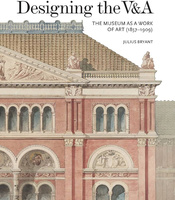
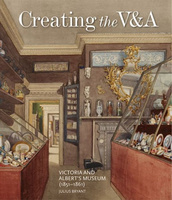
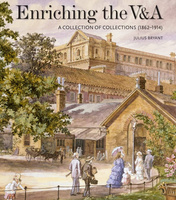
Julius Bryant,
Designing the V&A: The Museum as a Work of Art (1857–1909).
London: Lund Humphries and the V&A, 2017.
176 pp.; 208 color illus.; endnotes; index.
£39.95 (hardcover)
ISBN: 9781848222335
Creating the V&A: Victoria and Albert’s Museum (1851–1861).
London: Lund Humphries and the V&A, 2019.
176 pp.; 146 color and b&w illus.; bibliography; appendices; notes.
£39.95 (hardcover)
ISBN: 9781848223493
Enriching the V&A: A Collection of Collections (1862–1914).
London: Lund Humphries and the V&A, 2022.
176 pp.; 160 color illus.; notes; index.
£39.95 (hardcover)
ISBN: 9781848226180
All museums should have a Julius Bryant to research and write their institutional history. Bryant, now an emeritus keeper, began his career at the Victoria & Albert Museum (V&A) in 1981 and has organized exhibitions on subjects ranging from Tony Caro (2004) to John Lockwood Kipling (2018). The recent publication of Enriching the V&A: A Collection of Collections (1862–1914) completes the trilogy that was inaugurated with Designing the V&A: The Museum as a Work of Art (1857–1909) (2017) and continued by Creating the V&A: Victoria and Albert’s Museum (1851–1861) (2019). These volumes chart the origins and evolution of the first museum of applied arts, founded as an outgrowth of the Great Exhibition of 1851. Together they constitute a lucid history, beautifully designed with copious color images. These attributes are fitting given that the series honors arguably the most influential museum of the nineteenth century: the South Kensington Museum (SKM) as it was known until its royal renaming in 1899, an institution that fulfilled and went far beyond the ambitions of mid-Victorian British design reform advocates. The three volumes are meant as a series, sharing similar tone, format, and design, but are equally valuable as individual texts. While the first volume focuses on the architecture of the museum, the second takes as its overarching theme the role of the royal couple in shaping the identity of the museum. The third volume expands on this concern with its focus on the building of the collection, examining the other collectors, curators, and advisors who guided the evolution of the museum with the sourcing, purchasing, and donating of works of art. In addition to sharing visual commonalities, they are united by a meticulousness of research and clarity of writing that ensures that these volumes are essential reading for specialists and the general readership alike.
The first two volumes were published to coincide with events or anniversaries. In the case of Designing the V&A, the opening of a long-anticipated Exhibition Road entrance in 2017 (fig. 1); Creating the V&A marked the bicentennial of the birth of both Queen Victoria (1819–1901) and Prince Albert (1819–61), the royal couple whose names have been attached to the museum since 1899 (fig. 2). The final volume of the series does not accompany an exhibition; nor does it mark a special year. In many ways, however, it is the most ambitious as it examines the provenance of the collections: the collectors Bryant discusses are now visible only as part of the credit line of an object label rather than in the dedicated spaces that were often constructed as a condition of the gift or bequest. To revivify the names of Dixon, Ellison, or Forster that have been subsumed in the century and a half since their collections came to the museum is one of the organizing principles of Bryant’s third volume in the same way that uncovering the early building campaigns and the designers and artisans associated with them inform his first volume.
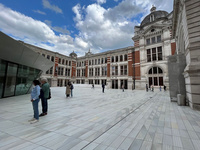
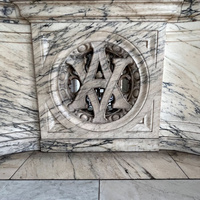
In this first volume, Designing the V&A, Bryant methodically demonstrates that the fabric of the museum, its architectural style both external and internal, acts as an index of design movements of its day. His recurring theme is that the innovative project of creating a purpose-built museum produced equally groundbreaking design and technological innovations. Further, the architectural style associated with the SKM was in large part aligned with the philosophy of the founding director. Thus, the multiple building campaigns under Henry Cole (1808–82) reflected his adoption of the notion of the museum as gesamtkunstwerke and an extension of his allegiance to nineteenth-century adaptation of Medieval and Renaissance building and decorative techniques (fig. 3). By contrast, Sir Cecil Harcourt Smith (1859–1944), director of the V&A between 1909 and 1924, covered up the interior flourishes, reflecting his own commitment to an early twentieth-century notion of the classicism of Greece and Rome. (In his previous position he had been Keeper of Greek and Roman Antiquity at the British Museum.) Bryant’s discussion of the various decoration campaigns reminds us that museum interiors are as much subject to trends and fashion as the objects held in those galleries. At the V&A, however, the specific “challenge of reconciling Victorian interiors with more contemporary settings for collections continues as a matter of debate, and resources” (Designing, 33).
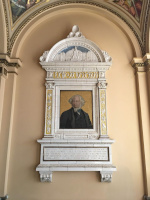
There is no better example of the book’s subtitle—the museum as a work of art—than the three refreshment rooms, which are covered in the third chapter of part 2, dedicated to “Designs and Decoration.” Bryant’s description of the plans for these rooms exemplifies his attention to detail, explicating the design process as well as the symbolism of the motifs deployed. The trio of exuberantly decorated rooms were the first restaurant in any museum and combine the provision of amenities for museum visitors and an opportunity for designers at the beginning of their careers. The two smaller rooms flanking the central, ceramic-clad Gamble Room are cases in point. Variously known as the Green Dining Room or the Western Refreshment Room, the Morris Room was an early commission (1865) for Morris, Marshall, Faulkner & Co., the firm established by William Morris (1834–96), that icon of the arts and crafts movement. With its distinctive green color scheme and zodiacal theme, the Morris Room was, as identified by Bryant, a collaboration of Philip Webb (1831–1915, bullseye bottle glass windows), Edward Burne-Jones (1833–98, stained glass), and Charles Fairfax Murray (1849–1919) with Dunn & Co. executing the designs. The evocative Elizabethan Revival style became a favored setting for the aesthetes James McNeill Whistler (1834–1903), George du Maurier (1834–96), and T. R. Lamont (1826–98), du Maurier immortalizing the group in Trilby (serialized in Harper’s from January through August 1894). Joining these artistic and literary figures was Edward Poynter (1836–1919), who was responsible for the designs of the other room to flank the central space. Drawing on the museum’s accounts, Bryant records that the members of the SKM’s Porcelain Class—Amy E. Black, Miss Cambridge, Miss Earle, Miss Hall, Miss Judd, and Miss Walker—were responsible for the painting of the figures of elegant ladies in decorative settings. As attuned to questions of design as Bryant is, he is equally cognizant of the socio-economic implications of the new museum, as well as the opportunities for working women. The refreshment rooms are one such example of the varied levels of society to whom the museum catered. Thus, the Dutch Kitchen or Grill Room (now known as The Poynter Room) (figs. 4, 5) was designated as the second-class dining room “where staff and students could eat more cheaply from a shorter menu” (Designing, 59). The economics of museum building can also be seen in the pay scale of those women porcelain painters, who earned six to nine pence an hour. It is difficult to imagine why the museum ever contemplated dismantling these rooms, but their renovation and reopening for their original purpose ensures that the V&A has one of the most photogenic museum cafeterias today.
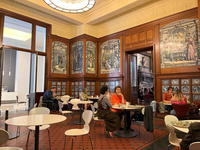
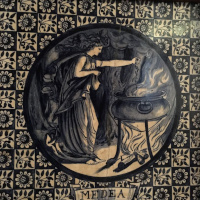
For those who have studied the architectural evolution of museums in former palaces, the complex challenge of adapting pre-existing buildings originally designed for a very different purpose is of central importance. In the case of the V&A, Bryant skillfully elucidates the process by which a purpose-built museum has expanded over the course of numerous construction campaigns. The result is that collections, such as the British paintings that constitute the John Sheepshanks (1787–1863) gift, originally sited in one suite of galleries, moved location as the footprint of the complex enlarged. Tracking these moves and their consequences requires detailed attention and while the volume is lavishly and usefully illustrated, more ground plans would have been useful. The relationship between the way the museum developed physically and the growth of its collections by gift or bequest is exemplified by the Sheepshanks collection, which as a collection of paintings tested the remit of an institution established to display the decorative arts. Bryant’s treatment of John Sheepshanks and his collection of Victorian paintings in the first two volumes plants the seed for the third volume dedicated to these discrete collections.
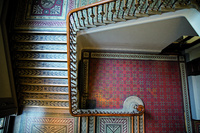
Throughout this, as well as the other two volumes, Bryant references the current state of the museum, widening the view from the narrow focus on the first decades. The author’s deep familiarity with the more recent history of the V&A provides necessary reminders that incidents from these early years continue to echo in current debates about the purpose of a museum of design, as well as the objects that are preserved within the galleries that are themselves markers of the institution’s commitment to contemporary relevance. As Tristram Hunt puts it in the foreword to the third volume, “the V&A’s focus has moved from collectors’ collections in favour of designers, patrons and consumers, as the V&A has reembraced its founding mission to be a resource for creativity and consumption” (Enriching, 6). The building itself, in Bryant’s telling, in its original fabrication and subsequent interventions takes on organic properties, going through the stages of novelty, and then old-fashionedness, only to be reborn again. Thus, “The marble mosaic floor in the V&A’s Sculpture in Britain Galleries (rooms 22–24) was revealed and restored in 2007, having been covered in black linoleum in the 1960s to save on maintenance costs” (Designing, 137). This marble mosaic floor (fig. 6) has a further layer of import: it was the product of Woking Female Prison inmates, and, because of its source of manufacture, was christened “opus criminale” by Henry Cole’s son, Alan Somerley Cole (1846–1934). This episode exemplifies the expense-conscious design solutions that were developed in the construction of the building, as well as the strategy of using design to improve lives, here through teaching production techniques to imprisoned women. Recent exhibitions such as Marking Time: Art in the Age of Mass Incarceration organized by Dr. Nicole Fleetwood at MoMA PS1 (September 2020–April 2021) have drawn attention to the social structures underlying the criminal justice system in the US; much more remains to be researched in the British context.
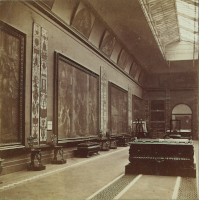
The second volume explores the role of Queen Victoria and Prince Albert in shaping the concept and collections of the museum. Albert’s active participation in the cultural arena has been well documented and analyzed extensively; the South Kensington campus which extends up Exhibition Road to Hyde Park, the Albert Memorial, and the Royal Albert Hall have long been known as Albertopolis.[1] His efforts to encourage reform in the visual arts of his adopted country were among the most well-received of his interventions in public policy. Victoria’s early and ongoing commitment to continuing her consort’s legacy is perhaps less well known and understood. As Bryant points out, the queen signaled her support in numerous ways. From visiting the Great Exhibition thirty-three times, to lending or giving objects from the Royal Collection, to visiting the museum and its new galleries as early as June 1863, just eighteen months after Albert’s death, Victoria, and the works of art that she lent or gave was a visible presence at an institution so closely tied to her husband. The “Raphael Cartoons” (fig. 7) have been displayed prominently at the museum since they were first lent in 1865. It is clear from the entries in her diary cited by Bryant that the queen’s allegiance to the museum was because of the association with her beloved husband. For example, the queen recounts another visit guided by Henry Cole, whose “rough, off-hand manner” could be forgiven because he “is so touchingly devoted to dearest Albert’s memory” (Creating, 152). Victoria’s final public ceremony of her long reign was in the laying of the foundation stone of the Cromwell Road entrance on May 17, 1899.
While the subtitle bookends the volume’s span as the first ten years of the institution’s existence, Bryant ranges far wider both in terms of date and personalities. As is clear from the first part of this volume, which examines the “Teaching Collection, 1837–1851,” the origins of the museum were, in fact, the collections formed to support the Government School of Design, established by Parliament in 1835–36, the year before Victoria ascended the throne at the age of eighteen. In that same year, these collections were put on view at Somerset House, the royal palace that had, the century before, been the first location of the Royal Academy of Arts. Bryant deftly shows that the museum was, in fact, the amalgamation of many other pre-existing institutions, including the Museum of Practical Geology and the Food Museum, to name just two. The result was, in Bryant’s understated verdict, that “. . . it was all rather more opportunistic and messier” (Creating, 96). How these varied departments were brought under a cohesive administration forms a recurring theme of the volume.
Furthermore, as attentive as Bryant is to the royals, he is equally elucidating about the role of other individuals who helped shape the museum in its early years. He is particularly acute in drawing out the importance of curators such as John Charles Robinson (1824–1913) and Richard Redgrave (1804–88). It is possible to detect over the three volumes slight shifts in Bryant’s position on the former, whose reputation has been the most subject to debate.[2] Robinson was a beneficiary of the opportunities provided by the system of regional schools put in place by the Government School of Design. Having served for five years as the headmaster of the government school of art in Hanley, Staffordshire, Robinson came to London in 1852 to become a Teachers’ Training Master at the School of Design; soon thereafter he was hired to assist with the collections at the Museum of Ornamental Art, which were first housed at Marlborough House near St. James’s Palace. An early advocate of the museum acquiring objects of historical significance, such as the sculptures in the Gigli-Campana collection, his position as curator at the SKM became increasingly embattled, especially from 1863 onwards, and he was dismissed at the end of 1867. Early in this second volume, Bryant takes a critical view of Robinson’s later account of the early years of the museum, noting “The idea of the V&A’s origins as a battle between commercialism and connoisseurship is a genesis myth promoted by Robinson himself in later life” (Creating, 17). Just a few chapters later, however, Bryant acknowledges that Robinson is the “hero” of the museum’s success at acquiring priceless objects of historic value on the European art market in the 1850s and 1860s (Creating, 57). As an advisor, Robinson returns to the museum after Cole’s death, supplying objects for purchase. In this capacity, examined in the final volume, Bryant eyes the curator-advisor-agent’s self-interest with skepticism, noting that Robinson’s offer in 1879 to lend the museum “a collection of instruments of torture, formerly used by the Inquisition” was declined, a possible confirmation that he was known to profit excessively from his sales to the museum (Enriching, 74).

Bryant considers the role of John Charles Robinson at length because he oversaw the acquisition of some of the museum’s most art-historically significant objects. Although Bryant does not explicitly make this point, it is clear from his narrative that the active presence of the museum as a purchaser in the auctions and private sales taking place both in the United Kingdom and on the Continent shifted the market. That is, in its ability to dedicate funds to make such purchases as the Donatello rilievo schiacciato of The Ascension with Christ giving the Keys to Peter (fig. 8) from the Gigli-Campana collection or the late sixteenth-century dish with an allegory of fecundity from the Pourtales-Gorgier sale held in Paris in 1865, the museum’s curators drew attention to and inevitably raised the prices of Renaissance sculpture, Spanish silver, and French Palissy ware. Not until the J. Paul Getty Museum began its high-profile acquisitions had a museum affected the art market so profoundly.
The other significant aspect of Robinson’s advocacy for such purchases, which Bryant addresses directly, is how these acquisitions steered the museum away from its founding mission. In all three volumes, Bryant details the way the museum’s remit to improve and, thereby, promote the design of British manufactures could be seen in the very design of the building and the exhibition program, as well as the contents of the displays. In this volume, the reader repeatedly sees the extent to which the growth of the collections presented the single greatest challenge to that mission. Because of donors’ often personal interests in a particular area, the acceptance of collections en bloc necessarily diverted curatorial attention away from a tight accession plan. Bryant’s recognition throughout the three volumes of the impact of individuals on the foundations of the V&A is, therefore, especially relevant in detailing the ways in which the museum’s holdings grew. Thus, while scholars and habitués of the museum today should be familiar with John Sheepshanks, Constantine Alexander Ionides (1833–1900), and Lady Charlotte Schreiber (1812–95), and their collections, Chauncy Hare Townshend (1798–1868), Stephen Wootton Bushell (1844–1908), and Robert Murdoch Smith (1835–1900) are not household names.
Bryant’s chapter entitled “Collectors as International Agents” is especially pertinent as he addresses the ways in which the museum’s collections grew as a result of the activities of those who were not independently wealthy amateurs. By drawing attention to figures who were crucial to the acquisition of examples of ceramics, metalwork, textiles, and other objects from the Iberian Peninsula, China, and Asia Minor, Bryant underscores how the global reach of the museum mirrored the reach of the British Empire, for better or worse. The meta-narrative is that collecting for an institution in the second half of the nineteenth century was not yet a profession per se, but that by enlisting the on-site expertise of agents, the museum was instrumental in the professionalization of curatorial practice. Major-General Robert Murdoch Smith, for example, was an officer in the Royal Engineers, a corps of the British Army that we have seen played an indispensable role to the construction of the building of the SKM. Among the more than seven hundred objects in the V&A’s collection associated with Smith is the Persian table top he commissioned from the Tehran workshop of Ali Muhammad Isfahani in 1887 (fig. 9).
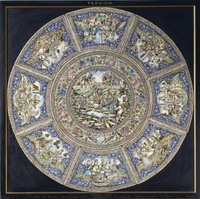
Another angle on “British” collecting emerges in these chapters. Although the South Kensington Museum is the quintessential expression of British taste and aspiration for and faith in improvement through education, the choice of frontispiece, a detail from Degas’s The Ballet Scene (1879), part of the bequest of modernist paintings by Ionides, exemplifies the complexity of its collecting history. Unlike other museums, founded as glorifications of a nation’s artistic heritage, the SKM was founded on the belief that British design was in dire need of improvement. Therefore, the examples considered worthy models were most frequently products from abroad, and, as with the Gigli-Campana collection, numerous collections acquired by the museum had been assembled by non-English collectors. For example, the Soulages collection of Venetian glass, Limoges enamels, Italian maiolica, and other decorative arts from the fifteenth and sixteenth centuries had been formed earlier in the century by Jules Soulages (1803–57) of Toulouse.
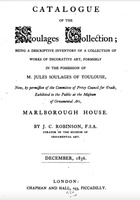
Bryant summarizes the long process by which the collection came to South Kensington as an example of the way in which Cole and Robinson were dependent on the government for acquisition funds. As we have seen in Cole’s often inventive approach to developing cost-conscious building solutions, finances were often top of mind to museum administrators, who were beholden to the government for operating and purchase funds. Albert’s support was essential, but his early death meant that the museum had to lobby for itself. Bryant quotes John Pope-Hennessy calling William Gladstone (1809–98) “the deus ex machina of the Museum in its early phase” (Creating, 59); in contrast, Lord Palmerston (1784–1865), the Liberal Prime Minister from 1855 until 1858, crucial early years of the SKM, was less generous with public funds. Thus, when solicited to supply the necessary £11,000 to purchase the entire Soulages Collection, which had been put on display at Marlborough House from December 5, 1856 to January 31, 1857 (fig. 10), Palmerston’s government refused. Instead, the Executive Committee of the Manchester Art Treasures Exhibition of 1857, who were in the process of organizing the first blockbuster fine art exhibition, formed a separate consortium and brought the collection to their purpose-built glass and iron palace constructed on the grounds of the Manchester Cricket Club in Old Trafford, a more salubrious suburb of the Lancashire industrial juggernaut. There, it was displayed in the central nave amongst the ten thousand works of decorative art drawn entirely from British private collections. Following the exhibition, Cole was able to pay for the objects in installments and even purchased the display cases that had been constructed for the temporary exhibition.[3]
There is much to be learned from Bryant’s three volumes, from the seemingly small fact that the designation of the area “South Kensington” was yet another Cole invention “to emphasize its proximity to Kensington Palace” (Designing, 37) to the identification of the museum’s second official photographer as Isabel Agnes Cowper (1826–1911), the sister of its first and better-known Charles Thurston Thompson (1816–68), or that by 1879 the museum owned over thirty thousand objects with nearly nineteen thousand additional objects on loan. Bryant’s grasp of the minutiae of the museum’s history is staggering. Even in the face of so much detail, Bryant never loses sight of the broader issues that make the evolution of the SKM such an important case in the history of museums. On occasion, Bryant places us in the position of a nineteenth-century museumgoer. For example, when describing the height and breadth of the iron and glass South Court, which opened to the public in 1862, he notes, “The impact on the Victorian visitor of discovering the South Court must have been like finding a vast new railway station soaring up in the middle of the museum” (Designing, 87). In the second volume, Bryant points to the guidebooks and early photographs, as well as to illustrations in magazines as useful sources to imagine the physical effect of the building when it was first constructed. In addition to published responses, it would have been useful to have had some private reactions aside from Queen Victoria’s. In fairness to Bryant, the reception of the museum by museum professionals, the general public and the artisans that were a target audience, as well as international visitors, is a topic worthy of an entire volume.
Bryant and the book designers make excellent use of these photographs and watercolors of the museum’s interiors. Indeed, a recurring theme is the extent to which the administrators recognized the importance of maintaining a visual record of the building and its contents. Usefully, Bryant devotes a chapter in Creating the V&A to “Exhibiting Photography.” In the early adoption of the medium for its practical uses in documenting the building and individual objects, as well as its aesthetic qualities, Prince Albert proved forward-thinking and a crucial advocate. This continued commitment to photography can be seen today in the newly opened galleries prompted by the acquisition of the collection of the Royal Photographic Society in 2017. Another aspect of the institution’s appreciation of the uses of three-dimensional reproductions is its acquisition and display of casts. Unlike other museums that displayed these casts prominently through the last decades of the nineteenth century, the V&A’s Cast Courts remain a signature attraction (fig. 11). Likewise, the extensive reports submitted by Robinson, Redgrave, and other curators reflect the bureaucratic procedures that are endemic to any branch of government (fig. 12).
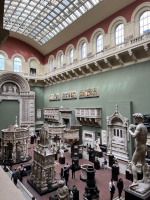
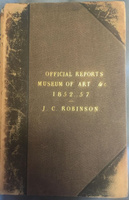
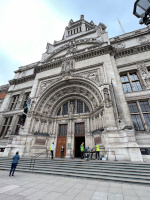
Although these volumes are not the place to analyze the influence that the V&A has had on museums around the world, there are instances where comparison with other institutions at this period might have brought into sharper focus the elements that have made the London museum unique. For example, the distinction of Aston Webb’s (1849–1930) late nineteenth-/early twentieth-century Cromwell Road entrance and façade (fig. 13) is clear when compared with that of Richard Morris Hunt’s (1827–95) for New York’s Metropolitan Museum of Art of nearly the same time. Hunt was chosen for his understanding of the French beaux-arts style. The resulting expanse of opulent neoclassicism filtered through French Second Empire idiom purposefully obscures the Ruskinian gothic of the museum’s original 1880 building, which had been directly inspired by the South Kensington style. Thus, imperial, encyclopedic ambition overlays the US municipal museum’s first allegiance to the ideas of popular education first promulgated by Cole and Prince Albert’s South Kensington complex. Not surprisingly, the French-infused beaux-arts vocabulary employed by Hunt is conspicuously absent from Webb’s Edwardian façade.
Bryant’s familiarity with the museum’s past, as well as its present, is undeniable. It is the fate, however, of studies like this to be continually falling out-of-date. An example of how the museum can change rapidly (and not always for the better) is the case of the National Art Library (NAL). In 2017 Bryant could write: “From the glass doors at the top of its staircase, the National Art Library presents a busy prospect of art research flourishing at the heart of the V&A” (Designing, 138). Now, the essential library for art researchers in London is only open three days a week. The discourse over the role of museums in society has also experienced a major reckoning in these years. In the latest publication, in the Director’s foreword, Tristram Hunt opens with an acknowledgment of the imperialism that has been at the foundation of many British collections (Enriching, 6). As recently as Hunt’s 2019 foreword, which refers to the popularity of the India Court at the Great Exhibition, he spins the importance of Britain’s colonial reach on the museum’s formation in purely positive terms, noting “At its very outset, the V&A was simultaneously a British, Continental and global endeavour” (Creating, 6).
Each volume stands alone as a thorough treatment of its stated subject; taken together, the series provides a near-exhaustive engagement with all aspects of the museum’s first half century. The research that is presented in these volumes has been incorporated in the V&A itself with useful wall panels that give information about the history of the building in the actual locations. In addition, the museum website includes useful pages drawn from Bryant’s volumes, broadening the access to the information the curator-writer has so painstakingly assembled in printed form. Although the latest volume brings the reader up to 1914 and Bryant frequently references changes that were made in the twentieth century, a history of the V&A of the past one hundred years remains to be written.
Notes
[1] John Steegman, Consort of Taste, 1830–1870 (London: Sidgwick and Jackson, 1950) was an early consideration of Prince Albert’s contribution to the arts in Britain. See also John Physick, Albertopolis: Prince Albert and the Royal Commission for the Exhibition of 1851 (London: Victoria & Albert, 1996). The Albert Memorial: The Prince Consort National Memorial: Its History, Contexts and Conservation, ed. Chris Brooks (New Haven and London: Yale University Press, 2000) is a comprehensive treatment of the monument.
[2] For a consideration of the literature on John Charles Robinson and the reasons behind the termination of his position, see Elizabeth A. Pergam, “John Charles Robinson in 1868: a Victorian curator’s collection on the block,” Journal of Art Historiography, no. 18 (June 2018), https://arthistoriography.files.wordpress.com/.
[3] For a detailed discussion of the negotiations for the Soulages Collection, see Elizabeth A. Pergam, “‘Waking the Soul’: The Manchester Art Treasures Exhibition of 1857” (PhD diss., Institute of Fine Arts, New York University, 2001), 153–54. The correspondence between Cole and the Executive Committee can be found in the General Out-Letter Books M6/2/4/3/381; 440; 557; 707 and M6/2/4/4/856, Manchester Central Library.